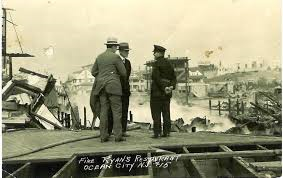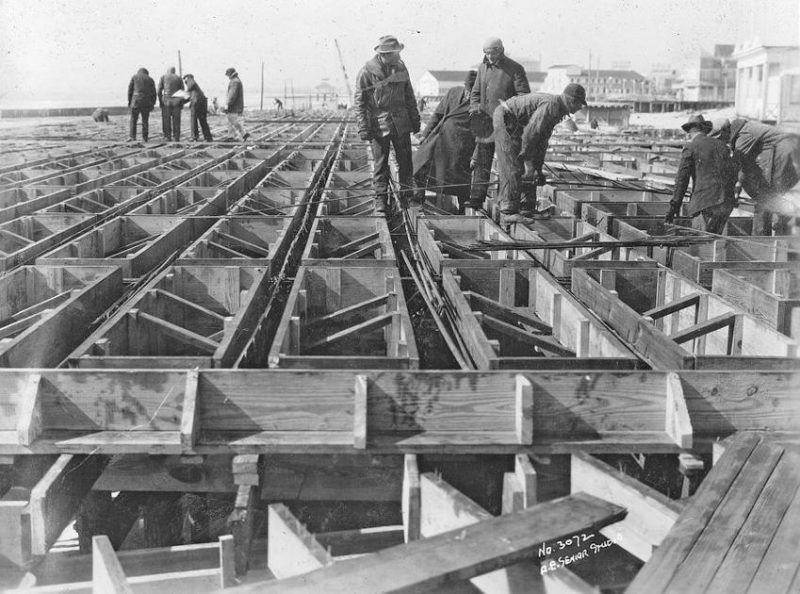Construction crews race to install a new section of the Boardwalk to get it ready for the 1928 summer tourism season. (Courtesy Bloximages)
 By Tim Kelly
The year was 1927. Babe Ruth smacked 60 home runs as a prelude to his New York Yankees’ World Series sweep of the Pittsburgh Pirates. Aviator Charles Lindbergh piloted his “Spirit of St. Louis” from New York to Paris in the first solo transatlantic flight. And a devastating fire of unknown origin destroyed nearly eight blocks of the Ocean City Boardwalk and surrounding areas.
All three events signaled tipping points in history. Ruth’s titanic homers and popularity ushered in the era of the celebrity athlete. Lindbergh’s daring flight made commercial aviation possible.
The so-called “Great Boardwalk Fire” that broke out 91 years ago to the day on Thursday, changed the way Ocean City looks, the way it fights fires, and the way it developed its famous wooden way.
“It was a catastrophic fire, but there was no loss of life,” said Al Crescenzo, one of the resident Great Fire experts at the Ocean City Historical Museum.
Nevertheless, because of the devastation it caused and the changes it inspired, the Great Fire of Oct. 11, 1927, remains “one of the biggest (disasters) and most important” in terms of its impact on Ocean City history, Crescenzo said.
The Great Fire:
· Resulted in the movement of a large section of Boardwalk to a location a full block closer to the beach and ocean.
· Leveled the Hippodrome Pier, the Wonderland or Castaway Cove of its day, and 30 other buildings, including the home of then-Mayor Joseph G. Champion.
· Resulted in a city ordinance banning building on the east, or ocean side of the Boardwalk.
· Replaced the formerly all-volunteer Fire Department to one of professional firefighters employed by the city.
By Tim Kelly
The year was 1927. Babe Ruth smacked 60 home runs as a prelude to his New York Yankees’ World Series sweep of the Pittsburgh Pirates. Aviator Charles Lindbergh piloted his “Spirit of St. Louis” from New York to Paris in the first solo transatlantic flight. And a devastating fire of unknown origin destroyed nearly eight blocks of the Ocean City Boardwalk and surrounding areas.
All three events signaled tipping points in history. Ruth’s titanic homers and popularity ushered in the era of the celebrity athlete. Lindbergh’s daring flight made commercial aviation possible.
The so-called “Great Boardwalk Fire” that broke out 91 years ago to the day on Thursday, changed the way Ocean City looks, the way it fights fires, and the way it developed its famous wooden way.
“It was a catastrophic fire, but there was no loss of life,” said Al Crescenzo, one of the resident Great Fire experts at the Ocean City Historical Museum.
Nevertheless, because of the devastation it caused and the changes it inspired, the Great Fire of Oct. 11, 1927, remains “one of the biggest (disasters) and most important” in terms of its impact on Ocean City history, Crescenzo said.
The Great Fire:
· Resulted in the movement of a large section of Boardwalk to a location a full block closer to the beach and ocean.
· Leveled the Hippodrome Pier, the Wonderland or Castaway Cove of its day, and 30 other buildings, including the home of then-Mayor Joseph G. Champion.
· Resulted in a city ordinance banning building on the east, or ocean side of the Boardwalk.
· Replaced the formerly all-volunteer Fire Department to one of professional firefighters employed by the city.
 Spectators watch as the huge blaze engulfs a building at Ninth Street. (Courtesy GenDisasters.com)
It also galvanized Ocean City’s government and residents in a unified effort to rebuild the Boardwalk and many of the businesses and homes in time for the start of the next tourism season’s kickoff, Memorial Day weekend of 1928.
The fire left a smoldering mass of rubble at its point of origin, including what used to be the Hippodrome’s carousel, partially melted by the intense heat of the blaze. In fact, mostly ruins remained throughout the fire’s eight-block path, which stretched from Moorlyn Terrace to 10th Street.
Strong winds played a huge role in the fire’s spread, and its containment when the wind changed direction.
“Not to knock the Ocean City firefighters (at the time of the Great Boardwalk Fire) but our department today is much better trained, staffed and equipped (to handle a large fire) than the department was in 1927,” said Ocean City Fire Chief Jim Smith. “With that said, a windswept fire like in 1927 is always a real concern for us in Ocean City.”
The exact cause of the fire was never determined, Crescenzo said. Two prevailing theories held that “vagrants” under the Boardwalk at the Hippodrome Pier on the ocean side of the boards at 10th Street had started a fire for warmth, which quickly grew out of control; and that a careless smoker’s discarded cigar ignited a trash pile at the same location.
Spectators watch as the huge blaze engulfs a building at Ninth Street. (Courtesy GenDisasters.com)
It also galvanized Ocean City’s government and residents in a unified effort to rebuild the Boardwalk and many of the businesses and homes in time for the start of the next tourism season’s kickoff, Memorial Day weekend of 1928.
The fire left a smoldering mass of rubble at its point of origin, including what used to be the Hippodrome’s carousel, partially melted by the intense heat of the blaze. In fact, mostly ruins remained throughout the fire’s eight-block path, which stretched from Moorlyn Terrace to 10th Street.
Strong winds played a huge role in the fire’s spread, and its containment when the wind changed direction.
“Not to knock the Ocean City firefighters (at the time of the Great Boardwalk Fire) but our department today is much better trained, staffed and equipped (to handle a large fire) than the department was in 1927,” said Ocean City Fire Chief Jim Smith. “With that said, a windswept fire like in 1927 is always a real concern for us in Ocean City.”
The exact cause of the fire was never determined, Crescenzo said. Two prevailing theories held that “vagrants” under the Boardwalk at the Hippodrome Pier on the ocean side of the boards at 10th Street had started a fire for warmth, which quickly grew out of control; and that a careless smoker’s discarded cigar ignited a trash pile at the same location.
 Two men talk to a police officer at the smoldering remains of Ryan's Restaurant.
Newspapers reported the fire started at 7 p.m. and had spread to other buildings on both sides of the Boardwalk within two hours.
“Ironically, the fire took place during what was then Fire Prevention Week,” said Crescenzo.
Two men talk to a police officer at the smoldering remains of Ryan's Restaurant.
Newspapers reported the fire started at 7 p.m. and had spread to other buildings on both sides of the Boardwalk within two hours.
“Ironically, the fire took place during what was then Fire Prevention Week,” said Crescenzo. Construction crews race to install a new section of the Boardwalk to get it ready for the 1928 summer tourism season. (Courtesy Bloximages)
When things looked their bleakest, residents pulled together. Groups of boys and young men unloaded items from stores and businesses in the path of the fire and piled them up on the beach. Neighbors used garden hoses to extinguish flames from rooftops of private homes, sparing many dwellings from destruction.
The Flanders Hotel, a state-of-the-art facility only four years old at the time, was probably the luckiest business in town. Not only did it suffer only minor damage, when the Boardwalk was moved toward the beach and ocean, it created a full-block area where the hotel’s iconic salt water pool was built. Today, the space is home to Playland’s Castaway Cove amusements.
After the blaze, Ocean City’s resolve only became stronger. The decision was made to use concrete and not wooden pilings on the replaced sections of the Boardwalk. In a “full circle” moment, recently replaced sections of the Boardwalk in the area of the fire replaced the crumbling decades-old concrete pilings with new ones of wood.
The disaster also resulted in formation of today’s paid city employee firefighters and the ordinance banning reconstruction of businesses on the ocean side of the boards. The Music Pier was the lone exception, Crescenzo said. It was immune to the law due to a “grandfather clause,” he noted.
According to Smith, fire codes in Ocean City were also toughened up as a result of the Great Boardwalk Fire.
Today’s fire codes and inspections are a big reason no such large-scale fires have been seen in Ocean City for decades, Smith said.
“People might complain about having to comply with such strict rules, but they make a big difference in limiting property damage” and saving lives, he added.
Construction crews race to install a new section of the Boardwalk to get it ready for the 1928 summer tourism season. (Courtesy Bloximages)
When things looked their bleakest, residents pulled together. Groups of boys and young men unloaded items from stores and businesses in the path of the fire and piled them up on the beach. Neighbors used garden hoses to extinguish flames from rooftops of private homes, sparing many dwellings from destruction.
The Flanders Hotel, a state-of-the-art facility only four years old at the time, was probably the luckiest business in town. Not only did it suffer only minor damage, when the Boardwalk was moved toward the beach and ocean, it created a full-block area where the hotel’s iconic salt water pool was built. Today, the space is home to Playland’s Castaway Cove amusements.
After the blaze, Ocean City’s resolve only became stronger. The decision was made to use concrete and not wooden pilings on the replaced sections of the Boardwalk. In a “full circle” moment, recently replaced sections of the Boardwalk in the area of the fire replaced the crumbling decades-old concrete pilings with new ones of wood.
The disaster also resulted in formation of today’s paid city employee firefighters and the ordinance banning reconstruction of businesses on the ocean side of the boards. The Music Pier was the lone exception, Crescenzo said. It was immune to the law due to a “grandfather clause,” he noted.
According to Smith, fire codes in Ocean City were also toughened up as a result of the Great Boardwalk Fire.
Today’s fire codes and inspections are a big reason no such large-scale fires have been seen in Ocean City for decades, Smith said.
“People might complain about having to comply with such strict rules, but they make a big difference in limiting property damage” and saving lives, he added.
 Ocean City Fire Chief Jim Smith says local fire codes were made stricter as a result of the 1927 disaster.
Several iconic Ocean City businesses rebuilt after the fire and endure today, including Shrivers’ Salt Water Taffy and Litterers, according to news reports. Other well-known businesses of the past such as Simms’ Restaurant and the Seaside Bath House were destroyed and then rebuilt.
“The movement of the Boardwalk allowed for large areas subsequently used for development,” according to Crescenzo. “Private homes, businesses, and parking lots are a few of the things people built on the new space. Others sold their expanded properties to real estate speculators, he said.
“Not only did the additional land create (economic opportunities) it expanded the city’s tax base by quite a bit.”
“All in all, October 11, 1927, was a big day in our history,” he said.
The Boardwalk was rebuilt and re-opened officially in time for the start of the next tourist season, Crescenzo noted.
“The city hosted a big celebration and held a parade to mark the new section of Boardwalk,” he said. “Can you imagine a project of that size being completed in that short a period of time today? But somehow, Ocean City pulled it off.”
Ocean City Fire Chief Jim Smith says local fire codes were made stricter as a result of the 1927 disaster.
Several iconic Ocean City businesses rebuilt after the fire and endure today, including Shrivers’ Salt Water Taffy and Litterers, according to news reports. Other well-known businesses of the past such as Simms’ Restaurant and the Seaside Bath House were destroyed and then rebuilt.
“The movement of the Boardwalk allowed for large areas subsequently used for development,” according to Crescenzo. “Private homes, businesses, and parking lots are a few of the things people built on the new space. Others sold their expanded properties to real estate speculators, he said.
“Not only did the additional land create (economic opportunities) it expanded the city’s tax base by quite a bit.”
“All in all, October 11, 1927, was a big day in our history,” he said.
The Boardwalk was rebuilt and re-opened officially in time for the start of the next tourist season, Crescenzo noted.
“The city hosted a big celebration and held a parade to mark the new section of Boardwalk,” he said. “Can you imagine a project of that size being completed in that short a period of time today? But somehow, Ocean City pulled it off.”